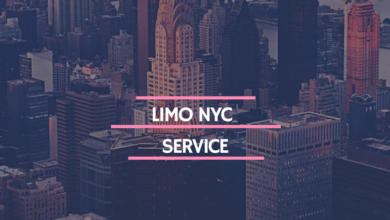What is digital marketing and its key elements?
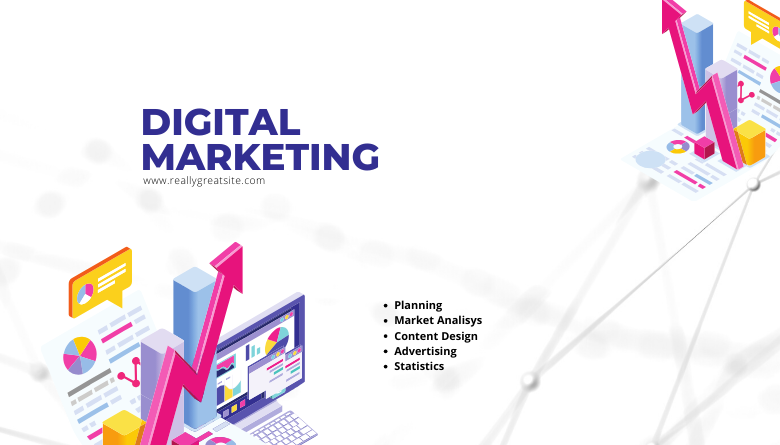

Digital marketing refers to the use of digital channels, platforms, and technologies to advertise and promote products, services, or products to target audiences. It encompasses a wide range of online marketing activities and strategies aimed at reaching potential customers through digital channels.
Some of the key elements of digital marketing are:
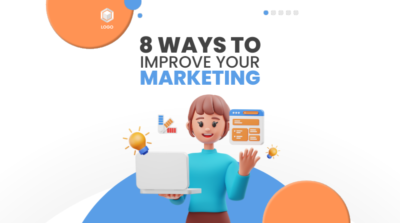

1. Search Engine Optimization (SEO): Website content is optimized to rank higher on search engine results pages, thereby increasing visibility and organic traffic. There are two types of SEO, on-page SEO and off-page SEO. In on-page SEO, target the keyword used in content, tags and article description. In off-page SEO, focus on backlinks for the website to gain more traffic and indexing.
2. Content Management: Create and distribute valuable, relevant, and consistent content to attract and engage the target audience. Content management enhances collaboration among teams by providing a centralized platform for content creation and editing. A well-managed content structure facilitates seamless navigation, leading to an improved user experience.
3. Social Media Marketing: Using social media platforms (such as Facebook, Instagram, Twitter, LinkedIn, etc.) to engage with audiences, build brand awareness, and drive traffic and leads.
4. Email Marketing: Sending targeted messages and promotions to a specific group of people via email to nurture leads and retain customers.
5. Paid advertising (PPC): It is a paid advertising campaign in which advertisers pay for each ad click. Some of the most commonly used are Google ads and social media ads.
6. Affiliate Marketing: Partnering with different corporations or individuals to promote products or services and incomes a fee for each sale or lead generated via the affiliate’s advertising efforts.
7. Influencer Marketing: Collaborating with influencers or people with a sizable following on social media structures to promote products or services.
8. Analytics and Data Analysis: Monitoring and analyzing statistics from digital advertising campaigns to measure overall performance, understand user conduct, and make knowledgeable decisions for optimization.
Which digital marketing course is best?
Choosing the first-rate virtual advertising path relies upon your specific goals, learning preferences, and finances. Numerous legitimate guides and certifications are available online, supplied by numerous structures and institutions. Here are some famous options:
1. Google Digital Garage: Google gives an unfastened online route overlaying numerous components of digital advertising and marketing, inclusive of SEO, social media, and analytics. It’s a terrific place to begin for beginners.
2. HubSpot Academy: HubSpot offers quite several loose publications on inbound marketing, content material advertising, social media methods, and more. They also offer certifications that may beautify your resume.
3. Coursera: Coursera hosts courses from universities and international organizations. The “Digital Marketing Specialization” by the University of Illinois and the “Digital Marketing MasterTrack™ Certificate” using the University of Toronto are properly regarded.
4. Udemy: Udemy has lots of digital advertising courses, ranging from novice to superior ranges. Courses like “Digital Marketing Masterclass 2022 – 23 Courses in 1” and “The Complete Digital Marketing Course” are famous selections.
5. LinkedIn Learning: Formerly referred to as Lynda.com, LinkedIn Learning gives guides on virtual marketing topics. Courses like “Online Marketing Foundations” and “SEO Foundations” may be useful.
6. Digital Marketing Institute (DMI): DMI offers a globally identified Professional Diploma in Digital Marketing. This comprehensive path covers diverse virtual advertising disciplines and is suitable for novices and professionals alike.
7. Copyblogger’s Internet Marketing for Smart People: This is a loose online path that covers essential concepts of online advertising, content advertising and marketing, electronic mail marketing, and more.
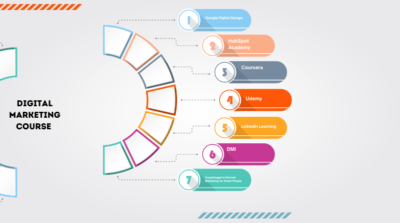

Before selecting a course, don’t forget the subsequent elements:
• Course Content: Ensure the direction covers the particular regions of virtual advertising you are inquisitive about, which include SEO, social media, content material marketing, and so forth.
• Instructor Expertise: Look for guides taught using enterprise specialists or specialists with real-world revel in digital advertising.
• Reviews and Ratings: Read critiques from other newbies to gauge the path’s effectiveness and best.
• Certification: Some courses offer certifications upon final touch, which could add price to your resume.
• Cost: Evaluate your finances and evaluate the value of the course with the cost it gives.
Remember that practical enjoyment is essential in virtual advertising, so take into account making use of the principles you research in real-global projects or through internships to boost your abilities.
How does digital marketing work?
Digital advertising operates through a whole lot of channels and techniques to connect organizations with their target market. Here’s a preferred overview of ways virtual advertising and marketing works:
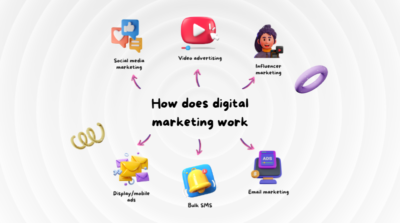

1. Understanding the Target Audience:
Businesses begin by way of figuring out their target audience. This involves growing targeted customer personas to understand the demographics, pastimes, and behaviors of capability customers.
2. Setting Objectives and Goals:
Digital marketing strategies are aligned with particular enterprise targets and goals. These ought to include growing emblem awareness, riding internet site site visitors, generating leads, or boosting income.
3. Choosing Digital Marketing Channels:
Businesses select the maximum relevant digital marketing channels based on their target market and dreams.
4. Search Engines (search engine optimization and PPC):
Optimizing web sites to seem to seek engine outcomes (search engine optimization) and going for walks paid advertising and marketing campaigns (PPC).
5. Social Media Marketing:
Engaging with the target audience on platforms like Facebook, Instagram, Twitter, LinkedIn, and many others.
6. Email Marketing:
Sending centered messages and promotions to a mailing listing.
7. Content Marketing:
Creating and distributing precious content via blogs, videos, and other formats.
8. Affiliate Marketing:
Partnering with affiliates to promote services or products on different social media platforms like YouTube and TikTok. One of the best ways to promote affiliate products is through the creation of a funnel. It means making a single landing page and attaching a payment method.
9. Influencer Marketing:
Collaborating with influencers to attain a broader target market.
10. Creating Compelling Content:
Content is a key issue of virtual advertising. Businesses create relevant and precious content material to attract and interact with their target audience. This can include blog posts, articles, films, infographics, and more.
11. Optimizing for Search Engines:
For better visibility on engines like Google, businesses optimize their websites and content material the use of search engine optimization strategies. This consists of key-word research, on-web page optimization, and constructing exquisite one-way links.
12. Implementing Paid Advertising:
PPC advertising entails creating centered commercials that appear whilst users look for unique key phrases. Businesses bid on key phrases and pay every time a user clicks on their advert.
13. Social Media Engagement:
Social media systems are used to connect with the target audience, share content, and build brand cognizance. Businesses engage with followers, reply to remarks, and participate in conversations.
14. Email Campaigns:
Email marketing is used to nurture leads and preserve customers. Businesses send personalized and focused emails to their mailing lists, selling products, presenting updates, and delivering precious content material.
15. Analyzing and Adjusting Strategies:
Digital marketing efforts are continuously monitored and analyzed using various analytics tools. Businesses track key performance indicators (KPIs) such as website traffic, conversion rates, and engagement metrics. Based on the data, strategies are adjusted and optimized for better results.
16. Conversion and Retention:
The ultimate goal of digital marketing is often to convert leads into customers and retain them. This involves providing a positive user experience, delivering value, and building long-term relationships with customers.
Digital advertising is dynamic and requires ongoing adaptation to changes in technology, consumer behavior, and the competitive landscape. Successful digital marketing strategies involve a combination of creativity, data analysis, and a deep understanding of the target audience.
Conclusion:
In the end, digital advertising and marketing is a dynamic and multifaceted method of selling products, services, or brands through digital channels and structures. It includes understanding and connecting with an audience, placing clean targets, and leveraging various online strategies to acquire business goals. From optimizing websites for engines like Google to being attractive to audiences on social media, growing compelling content material, and making use of paid marketing, digital advertising includes an extensive range of tools and techniques.

